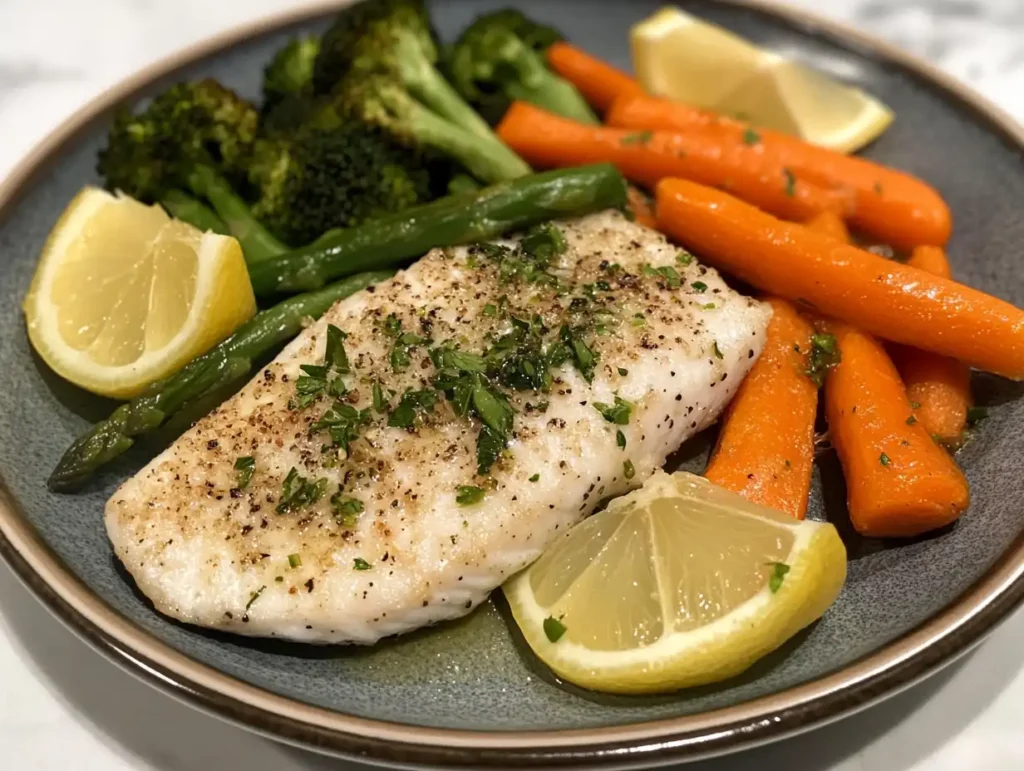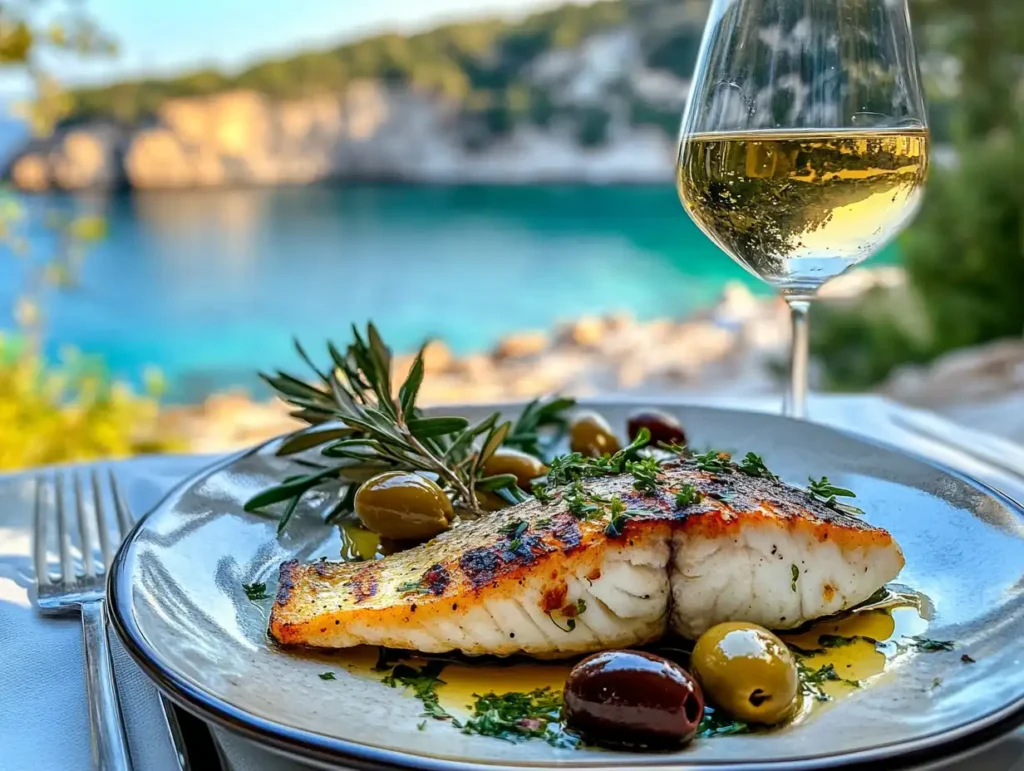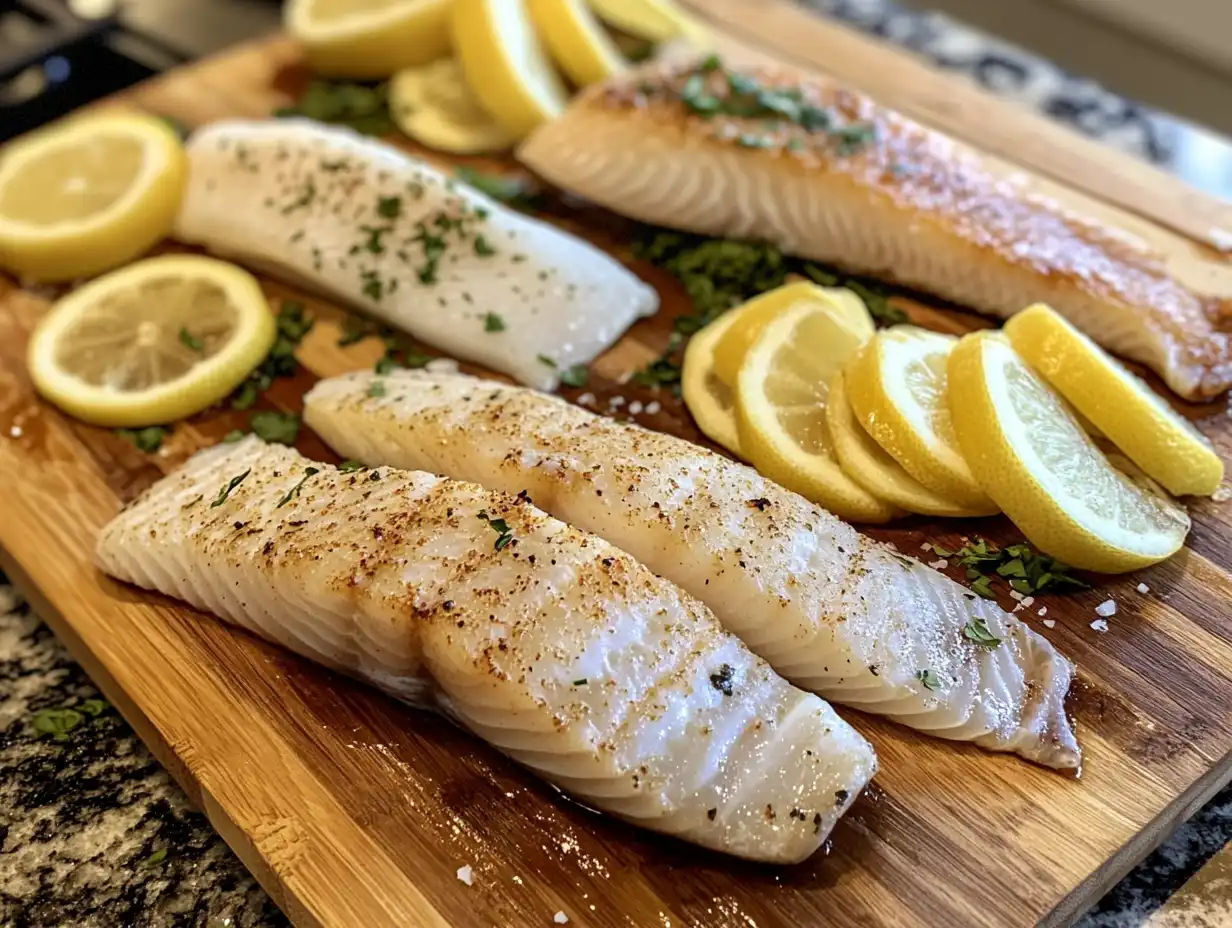Introduction
Is white fish good to eat? This is a common question for those seeking a nutritious and versatile protein option. White fish is a favorite in kitchens worldwide for its mild flavor and flexibility in recipes. It’s packed with nutrients, easy to cook, and fits well into many types of meals. Whether you’re trying to eat healthier or looking for a quick and tasty main dish, white fish is an excellent choice.
But is white fish good to eat for your overall health? Absolutely! It’s rich in lean protein, essential vitamins, and omega-3 fatty acids, all while being low in fat and calories. In this guide, we’ll explore what white fish is, its health benefits, risks to consider, and delicious ways to prepare it.
What is White Fish?
To understand is white fish good to eat, it’s helpful to know what qualifies as white fish. White fish refers to species with pale, flaky flesh and a mild taste. Unlike oily fish like salmon, white fish is low in fat and calories, making it a healthier choice for many diets. These fish live in freshwater and saltwater and are used in recipes worldwide. Their gentle flavor and quick preparation make them a top pick for easy and healthy meals.
Common Types of White Fish
If you’re still asking, is white fish good to eat when you want variety? The answer is a definite yes! White fish comes in many species, each offering unique textures and flavors. Here are some popular options:
- Cod: Known for its flaky texture and mild taste, cod works well for frying or baking.
- Haddock: Slightly sweeter than cod, haddock is perfect for smoked dishes or chowders.
- Tilapia: A firm-textured and affordable fish, tilapia adapts to many cooking styles.
- Halibut: With its dense flesh and slight sweetness, halibut shines when grilled or seared.
- Pollock: Often used in fish sticks or soups, pollock is a budget-friendly and tasty option.
- Flounder: This flatfish has a delicate texture and mild flavor, ideal for frying or baking.
With so many choices, it’s clear white fish is good to eat in countless recipes.
Nutritional Profile of White Fish
For those wondering, is white fish good to eat for a healthy diet? The answer is yes! White fish is packed with essential nutrients that support your health. Here’s a breakdown of its benefits:
- Protein: White fish provides lean protein, which helps repair and build muscles.
- Omega-3 Fatty Acids: While lower in fat than oily fish, white fish still offers heart-healthy omega-3s.
- Vitamins: It’s rich in B6 and B12, which support brain health and energy.
- Minerals: White fish contains selenium, phosphorus, and potassium, all vital for strong bones and muscles.
- Calories: It’s low in calories, making it ideal for weight management and heart health.
With these nutrients, it’s clear why white fish is good to eat as part of a balanced diet.
Health Benefits of Eating White Fish

High in Lean Protein
Is white fish good to eat for building muscle? Definitely. It’s packed with lean protein, which helps your body repair tissues and maintain energy. Many types of white fish provide over 20 grams of protein per serving, keeping you full and supporting weight loss goals.
Supports Heart Health
Another reason white fish is good to eat is its omega-3 fatty acids. These healthy fats lower inflammation, support brain function, and promote heart health. Halibut and pollock are excellent options if you want a moderate boost of omega-3s.
Rich in Vitamins and Minerals
If you’re still asking, is white fish good to eat for nutrients? The answer is a resounding yes. White fish delivers essential vitamins like B6 and B12, which boost energy and brain function. It also provides selenium for immunity and phosphorus for strong bones.
Potential Risks and Considerations
While white fish is good to eat, it’s important to consider a few potential risks.
Mercury Levels
Most white fish, such as cod and tilapia, have low mercury levels. However, it’s wise to limit your intake to 2–3 servings per week, especially if you’re pregnant or feeding young children.
Allergies
Some people experience allergies to fish, including white fish. If you’re trying it for the first time, start with a small portion to ensure you don’t have an adverse reaction.
Sustainability Concerns
Many ask, is white fish good to eat sustainably? The answer depends on how it’s sourced. To make eco-friendly choices, look for certifications like the Marine Stewardship Council (MSC) label and opt for local, responsibly sourced fish.
Farmed vs. Wild Fish
Farmed white fish, such as tilapia, can sometimes be exposed to antibiotics or poor farming conditions. Choosing certified, high-quality fish ensures you get the best for your health.
By understanding these considerations, you can enjoy white fish safely and responsibly.
Culinary Uses of White Fish
White fish is a culinary delight prized for its versatility and mild flavor, which makes it a favorite in kitchens worldwide. Whether you’re an experienced chef or a home cook, there are countless ways to prepare and enjoy white fish.
Popular White Fish Recipes
White fish is featured in a wide range of classic and contemporary recipes. Here are some popular dishes that highlight its adaptability:
- Fish Tacos: Grilled or battered white fish, such as cod or tilapia, served with fresh toppings like cabbage slaw, lime, and salsa.
- Baked Haddock: A simple dish with haddock fillets baked with breadcrumbs, herbs, and a drizzle of olive oil.
- Fish and Chips: The iconic British dish made with battered and deep-fried cod or haddock, served with fries and tartar sauce.
- Cioppino: A flavorful Italian-American seafood stew that often includes chunks of white fish alongside shellfish.
- Pan-Seared Halibut: Halibut steaks cooked to perfection with a golden crust, often served with a citrus or herb sauce.
Cooking Methods: Baking, Grilling, and Frying
White fish is versatile enough to be prepared using a variety of cooking techniques. Each method brings out different textures and flavors, making it suitable for diverse culinary styles.
- Baking: Ideal for low-fat cooking, baking white fish with seasonings, vegetables, and a splash of wine or broth keeps it moist and flavorful.
- Grilling: A smoky, charred flavor pairs beautifully with firm white fish like halibut or mahi-mahi. Use a grill basket to prevent delicate fish from breaking apart.
- Frying: Deep-frying or pan-frying creates a crispy crust, perfect for dishes like fish and chips or fish cakes.
- Poaching: Gently cooking fish in a liquid like broth, wine, or milk preserves its tenderness and highlights its natural flavor.
Pairing White Fish with Side Dishes
White fish pairs well with a variety of side dishes, complementing its mild taste and enhancing its presentation.
- Vegetables: Roasted asparagus, sautéed spinach, or steamed broccoli add a burst of color and nutrients.
- Grains: Serve white fish with rice, quinoa, or couscous for a balanced meal.
- Sauces: Light sauces like lemon butter, dill cream, or a tomato-based marinara elevate the dish without overpowering the fish.
- Potatoes: Mashed, roasted, or fried potatoes are classic accompaniments that work well with any preparation style.
Tips for Perfect Cooking
- Season Lightly: White fish’s mild flavor shines with simple seasonings like salt, pepper, lemon juice, and fresh herbs.
- Don’t Overcook: White fish cooks quickly; overcooking can result in a dry and rubbery texture. Aim for a flaky but moist consistency.
- Marinate for Flavor: A brief marinade with olive oil, garlic, and citrus can enhance the flavor without overwhelming the fish.
With its versatility, white fish is a blank canvas that lets you experiment with flavors, cuisines, and techniques.
White Fish in Different Cultures

White fish is a culinary staple around the world, celebrated for its adaptability and ability to take on diverse flavors. Each culture brings its own unique preparation methods and flavor profiles to white fish, creating dishes that range from simple to extravagant.
White Fish in Mediterranean Cuisine
In Mediterranean cooking, white fish often takes center stage thanks to its compatibility with the region’s fresh, wholesome ingredients. Some popular examples include:
- Grilled Sea Bass or Bream: Seasoned with olive oil, lemon, garlic, and herbs like thyme or oregano, these dishes are simple yet flavorful.
- Bouillabaisse: A traditional French seafood stew featuring a medley of fish, including white fish, cooked with saffron, tomatoes, and fennel.
- Bacalhau: In Portuguese cuisine, salt cod is a treasured ingredient used in dishes like Bacalhau à Brás (shredded cod with potatoes and eggs).
The Mediterranean diet emphasizes the use of olive oil, fresh vegetables, and aromatic herbs, making white fish dishes healthy and delicious.
White Fish in Asian Cooking
Asian cuisines highlight white fish in a variety of dishes that showcase bold flavors and creative techniques:
- Steamed Fish with Soy Sauce: A Cantonese classic where fish is steamed whole with ginger, scallions, and a savory soy-based sauce.
- Fish Curry: White fish is often used in Thai and Indian curries, absorbing the spices and coconut-based broths beautifully.
- Tempura Fish: In Japanese cuisine, white fish is lightly battered and fried, resulting in a crispy, delicate bite.
Asian preparations often emphasize preserving the fish’s natural flavor while incorporating vibrant spices and sauces.
White Fish in American Dishes
In the United States, white fish is a key ingredient in comfort food and contemporary cuisine alike:
- Fish Fry: A tradition in the Midwest, where white fish like perch or cod is battered and fried, typically served with coleslaw and fries.
- Chowders: New England clam chowder and similar variations often include chunks of white fish to enhance flavor and texture.
- Cajun Blackened Fish: White fish fillets coated with Cajun spices and seared in a hot pan for a smoky, spicy dish.
From hearty stews to crispy fried fish, American preparations highlight white fish’s adaptability across regions and tastes.
A Global Connection
White fish’s mildness makes it a universal favorite, seamlessly blending into diverse cuisines while allowing regional ingredients and techniques to shine. Its presence on menus around the world underscores its appeal and versatility.
Frequently Asked Questions (FAQs)
Is white fish healthier than oily fish?
Both white fish and oily fish have distinct health benefits, making them important parts of a balanced diet. White fish is lower in fat and calories, making it a great choice for those focusing on weight management or reducing fat intake. Oily fish, on the other hand, is richer in omega-3 fatty acids, which are crucial for heart and brain health. Incorporating both types of fish into your diet can help you enjoy the benefits of each.
How often can you eat white fish safely?
For most people, eating white fish 2–3 times a week is considered safe and nutritious. Due to their lower mercury content, species like cod, haddock, and tilapia are excellent choices for frequent consumption. However, it’s important to follow dietary guidelines, especially for vulnerable groups like pregnant women and young children.
What are the best white fish for kids?
White fish with mild flavors and minimal bones, such as cod, haddock, or tilapia, are ideal for children. These fish are easy to prepare, digest, and enjoy. Serve them baked or grilled with kid-friendly sides like mashed potatoes or vegetables for a healthy, balanced meal.
Does white fish have bones?
Most white fish have bones, but they are often removed during filleting. Depending on the preparation, you can find boneless fillets readily available at supermarkets or fish markets. When cooking whole fish, be sure to remove the bones before serving, especially when preparing meals for children or guests.
Are there vegetarian alternatives to white fish?
Yes, several plant-based options mimic the texture and taste of white fish. Products made from jackfruit, hearts of palm, or soy-based substitutes are popular among vegetarians. Additionally, certain mushrooms and tofu can be seasoned and prepared to replicate the mild flavor of white fish.
How can I ensure my white fish is sustainable?
To ensure you’re purchasing sustainable white fish, look for certifications like the Marine Stewardship Council (MSC) or the Aquaculture Stewardship Council (ASC) labels. Choose local fish species where possible and avoid overfished varieties. Always ask your fishmonger about the origin of the fish to make eco-conscious choices.
Explore Related White Fish Topics
Discover more about white fish and its culinary and nutritional aspects with these articles:
- Dive into the health and culinary benefits in White Fish: The Ultimate Guide to Its Benefits and Uses for a well-rounded understanding.
- Learn about a popular option in Is Branzino a Good Fish to Eat? and why it’s a top choice for many.
- Explore preparation tips in How Do You Cook and Eat Branzino? to bring out the best flavors in your dishes.
These resources provide valuable insights to help you appreciate and make the most of white fish!
Conclusion
White fish is a versatile, nutritious, and delicious option for those seeking a healthy and sustainable protein source. Its high protein content, essential vitamins, and heart-friendly properties make it a valuable addition to a balanced diet. From grilled halibut to classic fish and chips, white fish adapts to countless recipes and cooking techniques, catering to diverse tastes and culinary traditions worldwide.
While enjoying white fish, it’s essential to consider factors like mercury content, allergies, and sustainability to ensure safe and responsible consumption. By making informed choices and exploring the diverse cultural preparations of white fish, you can savor its benefits and flavors while supporting a sustainable food future.
Whether you’re a seasoned cook or a novice in the kitchen, white fish offers endless possibilities to create healthy and satisfying meals for yourself and your loved ones.
